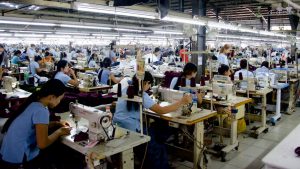THE Department of Trade and Industry is set to meet with a garment manufacturer from Hong Kong by the end of the month to discuss plans of expanding its production in the Philippines.
“They are already thinking of strengthening and adding more production in the Philippines because of the 17% US reciprocal tariffs,” Trade Secretary Ma. Cristina A. Roque told reporters last week.
“I will talk to them about their plans to grow here in the Philippines. They’re going to expand their production here,” she added.
She said that the Hong Kong manufacturer’s decision is based on the assumption that the US reciprocal tariff for Philippine products will stay at 17%, the second lowest tariff in the Association of Southeast Asian Nations (ASEAN).
ASEAN member countries are facing some of the highest duties. Cambodian goods must pay a 49% tariff, followed by Laos (48%), Vietnam (46%), Myanmar (44%), Thailand (36%), Indonesia (32%), Malaysia (24%), and Brunei (24%).
Singapore was assigned the baseline tariff of 10%.
Last week, US President Donald J. Trump announced a 90-day pause on the higher reciprocal tariffs on most of its trading partners.
While the 90-day pause is in place, most countries will be charged the 10% duty until July.
“(The Hong Kong manufacturer is) thinking that it will stay at 17%. But it’s hard to say; it is hard to speculate,” Mr. Roque said.
“The best thing to do is really to just wait. But now, (investors) are already talking to us,” she added.
Foreign Buyers Association of the Philippines President Robert M. Young said the Philippines should upgrade its capabilities and reduce the cost of doing business as more companies explore Philippine expansions to get around stiff US tariffs in their home countries.
“We have been telling people that we just have to invite investors to come in and open new factories, modernized factories, updated factories, and state-of-the-art factories that can stitch fashion items. We only have basic ones, and that is the problem,” he said by telephone.
“There are factories here, but they are dedicated to the companies’ own production; they do not have the capacity to accept additional orders,” he added.
He said that the Philippines lost a lot of investments to Vietnam due to the high cost of doing business here.
Meanwhile, Mr. Young said that he expects US reciprocal tariffs to disrupt trade activity globally as economies turn protectionist.
“There will be a policy shift towards protectionism,” he said.
He said that this could result in lower orders from US companies, with the Philippines raising prices due to higher prices of raw materials.
“As you know, the Philippines is just relying on imported materials, almost in all industries. Prices will definitely increase because the other countries that are supplying the Philippines will be affected as well by this tariff,” he added.
According to the World Trade Organization’s (WTO) Global Trade Outlook, world trade is expected to decline 0.2% in 2025 due to a surge in tariffs and trade policy uncertainty.
The WTO said that if the US imposes the currently suspended reciprocal tariffs, world merchandise trade growth will be reduced by an additional 0.6 percentage points.
Earlier this year, the WTO projected Asia’s exports to register 3.3% growth in 2025, with imports expected to grow 3.2%. However, WTO economists revised these projections in April to 1.6%.
Meanwhile, Asia’s commercial services exports are expected to grow 4.4% this year based on April projections, from 5.5% previously.
Mr. Young said that he expects a significant decrease in Philippine exports compared to other ASEAN economies due to higher prices.
“Originally, we had higher prices than them. For instance, in denim jeans our price is at least 15% higher than that of Bangladesh or Vietnam, or sometimes even 20%. Philippine jeans will be the last to be picked up because they now have this perception that the Philippines is charging more,” he said.
“Definitely the demand for the Philippine exports will be less as compared to the other ASEAN countries,” he added.
He said the government should be aggressive in reducing the cost of doing business through subsidies for power costs and other such measures.
“We are now all in survival mode. Because all in all, the Trump tariff reduces global merchandise activity. International economic growth will definitely be stunted,” he said.
“Our buyers are suggesting cost-cutting to us to offset or somehow assist in the reduction of prices,” he added.
According to the WTO report, world gross domestic product growth is now projected at 2.2% in 2025, down from 2.8% previously.
Rizal Commercial Banking Corp. Chief Economist Michael L. Ricafort said that the US tariffs and other protectionist measures can slow global trade, investment, employment, and world economic growth.
“This would lead to slower Philippine exports, including supply chains and overall economic growth,” he said.
He said the Philippines should diversify export markets while leveraging its free trade agreements (FTA), adding that the US remains its biggest export market with a 17% share.
He added that the Philippines should also try to reduce US tariffs through an FTA and diversify beyond electronics. — Justine Irish D. Tabile

